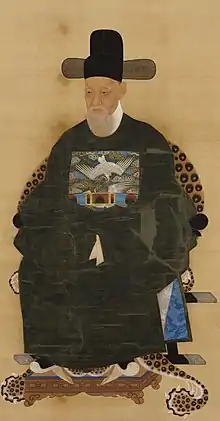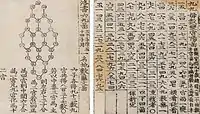Choi Seok-jeong 최석정 | |
|---|---|
 | |
| Chief State Councillor | |
| In office 5 May 1705 – 24 April 1710 | |
| Preceded by | Sin Wan |
| Succeeded by | Yi Yeo |
| In office 27 March 1703 – 29 July 1703 | |
| Preceded by | Seo Mun-jung |
| Succeeded by | Sin Wan |
| In office 24 July 1701 – 31 October 1701 | |
| Preceded by | Seo Mun-jung |
| Succeeded by | Seo Mun-jung |
| Left State Councillor | |
| In office 12 April 1699 – 16 July 1699 | |
| Preceded by | Yi Se-baek |
| Succeeded by | Seo Mun-jung |
| Right State Councillor | |
| In office 3 April 1697 – 13 July 1698 | |
| Preceded by | Seo Mun-jung |
| Succeeded by | Yi Se-baek |
| Personal details | |
| Born | 2 July 1646 |
| Died | 6 December 1715 (aged 69) |
| Spouse | Lady Yi Gyeong-eok of the Yi clan |
| Children | Choe Chang-dae (son) |
| Parents |
|
| Choi Seok-jeong | |
| Hangul | |
|---|---|
| Hanja | |
| Revised Romanization | Ch'oe Seok-jeong |
| McCune–Reischauer | Choi Sŏk-ch'ŏng |
| Art name | |
| Hangul | |
| Hanja | |
| Revised Romanization | Jonwa, Myeonggok |
| McCune–Reischauer | Ch'onwa, Myŏngkok |
| Childhood name | |
| Hangul | |
| Hanja | |
| Revised Romanization | Seokman |
| McCune–Reischauer | Sŏkman |
| Courtesy name | |
| Hangul | |
| Hanja | |
| Revised Romanization | Yeosi, Yeohwa |
| McCune–Reischauer | Yŏsi, Yŏhwa |
| Posthumous name | |
| Hangul | |
| Hanja | |
| Revised Romanization | Munjeong |
| McCune–Reischauer | Munch'ŏng |
Choi Seok-jeong (Korean: 최석정; Hanja: 崔錫鼎; 1646–1715) was a Korean politician and mathematician in the Joseon period of Korea.
He published the Gusuryak (Korean: 구수략; Hanja: 九數略) in 1700,[1] the first known literature on Latin squares,[2] predating Leonhard Euler by at least 67 years.[3][4] He also invented the hexagonal tortoise problem.[5] Choi was a member of the Jeonju Choe clan.
Choi Seok-jeong Award
The Choi Seok-jeong Award was created in 2021 to recognize those who develop or spread mathematics.[6] Spelling of laureates' names matches their Wikipedia page, if it exists, the remainder used Revised Romanization of Korean with the Korean Romanization Converter of Al Lab and Narainfotech.
| Year | Laureates | Affiliation |
|---|---|---|
| 2021[7] | Kim Jae Kyoung Im Seonhui Song Hongyeop |
KAIST/Institute for Basic Science Seoul National University Yonsei University |
| 2022[8] | Kang Myeongju Oum Sang-il Hwang Hyeongju |
Seoul National University KAIST/Institute for Basic Science POSTECH |
References
- ↑ "구수략(九數略)". 규장각 문화재청. Seoul National University Kyujanggak Institute for Korean Studies. Retrieved 11 April 2017.
- ↑ Colbourn, Charles J.; Dinitz, Jeffrey H. (2 November 2006). Handbook of Combinatorial Designs, Second Edition. CRC Press. p. 12. ISBN 9781420010541. Retrieved 28 March 2017.
- ↑ Ree, Sangwook (August 15, 2014). "Confucian scholar's discovery predates the work of Euler" (PDF). Math&Presso. Vol. 3. International Congress of Mathematicians.
- ↑ Kim, Sung Sook (2012). Orthogonal Latin Squares of Choi Seok-Jeong (PDF). History and Pedagogy of Mathematics. Archived from the original (PDF) on 5 April 2017. Retrieved 28 March 2017.
- ↑ Proceedings of the Genetic and Evolutionary Computation Conference. Morgan Kaufmann Publishers. 2002. p. 689. ISBN 9781558608788. Retrieved 28 March 2017.
- ↑ "CI Jae Kyoung Kim won '올해의 최석정상.' Congratulation!". Biomedical Mathematics Group. Institute for Basic Science. Retrieved 29 September 2022.
'올해의 최석정상' (Choi Seok-jeong award in this year) is named after Choi, Seok-jeong who was a Korean politician and mathematician in the Joseon period of Korea. This award was established 2021 to give mathematicians credit for developing and applying mathematics or spreading mathematics culture.
- ↑ "김재경 교수, 올해의 최석정상 수상". Mathematical Sciences (in Korean). KAIST. 30 November 2021. Retrieved 15 December 2022.
- ↑ 유용하 (13 December 2022). "올해의 최석정상 수상자 서울대 강명주·카이스트 엄상일·포스텍 황형주 교수" (in Korean). Seoul Shinmun. Retrieved 15 December 2022.

Gusuryak by Choi Seok-jeong, published in 1700
This article is issued from Wikipedia. The text is licensed under Creative Commons - Attribution - Sharealike. Additional terms may apply for the media files.